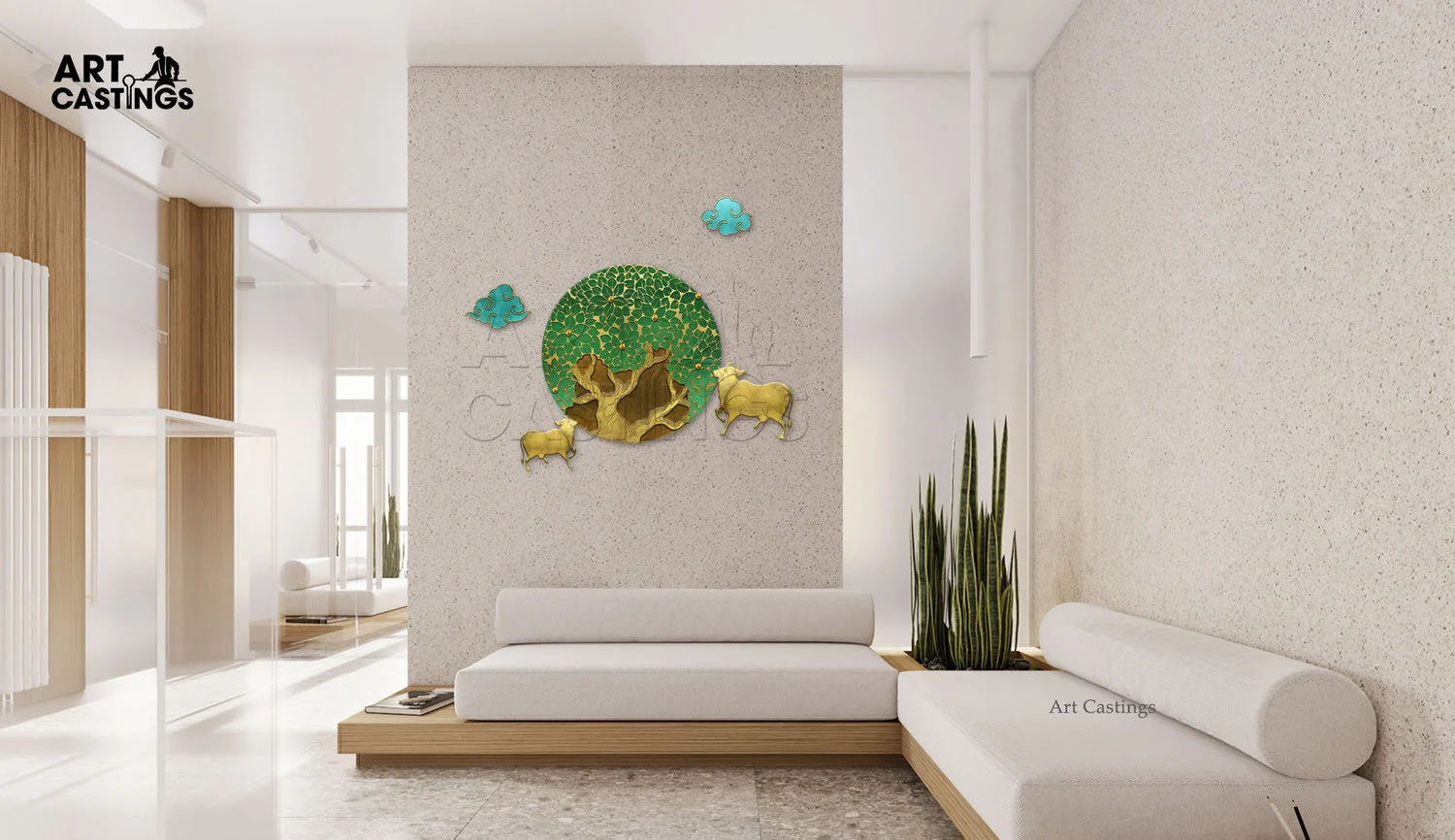“Cultural Reverence in Art: The Symbolism and Significance of Brass Cow and Calf Wall Murals”
Wall murals have long been a means to tell stories, express cultural values, and add meaningful symbolism to spaces. In Indian homes, one particularly cherished design is the brass cow and calf wall mural with a tree. This mural beautifully captures the deep cultural and spiritual importance of cows in Hindu tradition. Merging art beauty with spiritual meaning, it celebrates nature, nurturing, and the divine bond between mother and child.
The Symbolism of the Cow and Calf in Hindu Culture
In Hinduism, the cow holds a revered status as a sacred animal. It symbolizes abundance, nurturing, and the Earth itself. Often referred to as Kamadhenu, the cow is seen as the provider of all sustenance and a symbol of wealth and maternal care. The image of the cow alongside her calf evokes the purest form of love—maternal affection. This bond represents nurturing and protection, with the cow embodying the unselfish giving nature that sustains life.
The calf, suckling from its mother, represents innocence, purity, and the continuity of life. Together, the cow and calf symbolize the cycle of life and the interconnectedness of all beings, a central concept in Hindu philosophy. The mural’s depiction of these gentle creatures reminds us of the values of care, compassion, and sustenance.
Brass – A Timeless Material
Brass has deep associations with divinity and spirituality in Indian culture. Moreover, brass is linked to positive energy, resilience, and warmth, qualities that make it a perfect choice for home décor intended to bring peace and prosperity.
Unlike other metals, brass reflects light in a way that creates a welcoming and serene ambiance within a home. Over time, it develops a natural patina, giving the mural a timeless appearance reminiscent of ancient Indian traditions. Its ensures that such pieces remain a part of the household’s spiritual and decorative heritage for generations.
The Tree – A Symbol of Life and Growth
In addition to the cow and calf, the tree in this mural plays a key role in the narrative. It symbolizes life, growth, and humanity’s connection to nature. Across many cultures, the tree stands as a symbol of longevity, strength, and nurturing. The Tree of Life, a concept frequently depicted in Indian art, represents the interconnectedness of all beings. The roots, deeply embedded in the earth, and the branches reaching towards the sky symbolize the harmony between the physical and spiritual worlds.
In the brass cow and calf wall mural, the tree adds further depth to the scene, emphasizing ideas of fertility, shelter, and the sustenance that nature provides. Together, the tree, cow, and calf tell a story of life’s nurturing cycle, with the tree symbolizing the Earth’s support and the cow reflecting nature’s selfless giving.
Spiritual Impact in Modern Homes
The brass cow and calf wall mural with a tree is more than just a decorative item—it enriches spaces with cultural significance and spiritual value. When displayed in living rooms or at the entrance of a home, it symbolizes abundance, prosperity, and peace. Its calming presence fosters an atmosphere of serenity, reminding us of the importance of compassion, kindness, and living in harmony with nature.
For modern households seeking to balance tradition and contemporary style, this brass mural offers an ideal solution. Its timeless beauty ensures it complements both modern and traditional interiors, adding elegance and spiritual grounding to any space.
Conclusion
The brass cow and calf wall mural with a tree is not just a piece of art. It represents nurturing, prosperity, and the eternal bond between mother and child. By combining the spiritual significance of the cow in Hinduism with the life-giving symbolism of the tree and the enduring beauty of brass, this mural becomes a meaningful addition to any home. It serves as a constant reminder of our connection to nature and the importance of living in harmony with the world around us.



Leave a comment
Your email address will not be published. Required fields are marked *